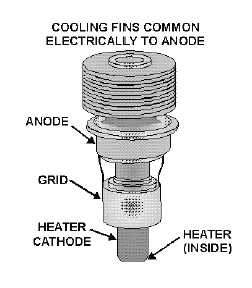2-14
capacitor in a cathode-biased circuit. Because the capacitor will not pass dc, bias voltages can be applied
to the cathode through the tube pins.
Notice the external shape of the planar tube in figure 2-13. The tube is composed of five sections, or
cylinders. As you go from the top to the bottom, each cylinder increases in diameter. Because of this piled
cylinder construction, the tube resembles a lighthouse, and is therefore known as a LIGHTHOUSE
TUBE.
Another type of planar tube is shown in figure 2-14. This type of tube, because of its external
appearance, is called an OILCAN TUBE. The major difference between it and the lighthouse tube is the
addition of cooling fins to allow it to handle more power than the lighthouse tube. Because of their planar
construction, both types of tubes are capable of handling large amounts of power at uhf frequencies.
Figure 2-14.—Oilcan planar tube.
Q6.
What effect does transit time have on a conventional triode operated at uhf frequencies?
Q7.
How do uhf tubes counter the effects of transit time?
Q8.
Why can acorn and doorknob tubes NOT handle large amounts of power?
Q9.
What type of uhf tube was developed to handle large amounts of power?
GAS-FILLED TUBES
You know that great effort is made to produce a perfect vacuum within electron tubes. But, even the
best vacuum pumps and getters cannot remove all of the air molecules. However, the chances of an
electron hitting a molecule in a near-vacuum are very slim because of the great distance between the
molecules, compared to the size of the electron. An electron can pass between two molecules of air inside
the tube as easily as a pea could pass through a circle with a diameter equal to that of the earth!
In some tubes, the air is removed and replaced with an inert gas at a reduced pressure. The gases
used include mercury vapor, neon, argon, and nitrogen. Gas-filled tubes, as they are called, have certain

